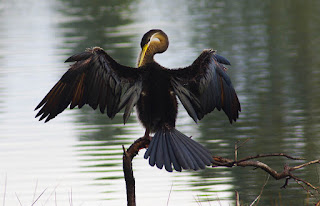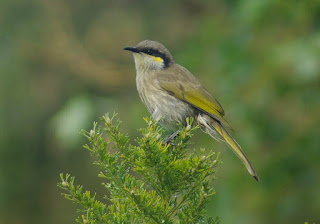The New Holland Honeyeater is a honeyeater species found throughout Southern Australia, from about Brisbane, Queensland to just north of Perth in Western Australia. It was among the first birds to be scientifically described in Australia 1781 and was initially named Certhia Novaehollandiae.
It is a very active bird, and rarely sits long enough to give an extended view. When danger approaches a group of Honeyeaters will form together and give a warning call.
The New Holland Honeyeater is common in heath, forests and woodlands, mainly where grevilleas and banksias are found. It's inquisitive and approaches humans. It also mixes with other honeyeaters as Red Wattlebird, Singing Honeyeater, Brown Honeyeater, all described in this blog.
The birds are also very active feeders, they mostly eat the nectar of flowers (Photo1) and busily dart from flower to flower in search of this high energy food. Other food items include fruit, insects and spiders. Birds may feed alone but normally gather in quite large groups. Most feeding take place in lower areas of bushes and thickets.
Its cup-shaped nest is made of bark and grasses, bound together with spider web. Its lined with soft material and is placed in the bush or tree, anywhere from ground level up to six meters. Both sexes feed the chiks. A pair of adults may raise two or three broods in a year.
Photos taken: 1,4 Swan River (Belmont) 2,3 Lightning Swamp bush land, 5 Bickley Brook
Ptič spada v vrsto medojedcev in ga je mogoče najti po vsej Južni Avstraliji od okoli Brisbana, Qwenslanda vse do severno od Pertha v Zahodni Avstraliji. Ta vrsta je bila ena med prvimi znanstveno opisanimi vrstami v Avstraliji leta 1781 in že od začetka poimenovana Certhia Novaehollandiae.
Je zelo aktiven ptič in redko sedi na veji toliko časa da bi ga lahko dalj časa opazovali. Ko se mu približa nevarnost se skupina teh ptičev združi in odda svarilni klic.
Ptiča najdemo v resju, gozdovih in grmovju, večinoma kjer rastejo grevileje in banksije. Je radoveden ptič in se zlahka približa človeku. Druži se tudi z drugimi ptiči iz vrste medojedcev kot so Red Wattlebird, Singing honeyeater in Brown honeyeater, vsi že opisani v tem blogu.
Ptič je tudi zelo aktiven jedec, večinoma se hrani z cvetnim nektarjem in neprestano leta od cveta do cveta v iskanju te visoko energetske hrane. Ostala hrana na jedilniku vključuje sadje, insekte in pajke. Ptič se lahko hrani sam normalno pa v družbi večje skupine. Večinoma najde hrano v nizkem grmičevju in goščavju.
Njegovo Čašasto oblikovano gnezdo je narejeno iz lubja in trave, povezano z pajčevino. Je obloženo z mehkim materijalom in zgrajeno v grmovju ali drevesih, do šest metrov od tal. Oba spola hranita mladiče. Par odraslih ptičev lahko vzgoji dve ali tri gnezda na leto.
Its cup-shaped nest is made of bark and grasses, bound together with spider web. Its lined with soft material and is placed in the bush or tree, anywhere from ground level up to six meters. Both sexes feed the chiks. A pair of adults may raise two or three broods in a year.
Photos taken: 1,4 Swan River (Belmont) 2,3 Lightning Swamp bush land, 5 Bickley Brook
Ptič spada v vrsto medojedcev in ga je mogoče najti po vsej Južni Avstraliji od okoli Brisbana, Qwenslanda vse do severno od Pertha v Zahodni Avstraliji. Ta vrsta je bila ena med prvimi znanstveno opisanimi vrstami v Avstraliji leta 1781 in že od začetka poimenovana Certhia Novaehollandiae.
Je zelo aktiven ptič in redko sedi na veji toliko časa da bi ga lahko dalj časa opazovali. Ko se mu približa nevarnost se skupina teh ptičev združi in odda svarilni klic.
Ptiča najdemo v resju, gozdovih in grmovju, večinoma kjer rastejo grevileje in banksije. Je radoveden ptič in se zlahka približa človeku. Druži se tudi z drugimi ptiči iz vrste medojedcev kot so Red Wattlebird, Singing honeyeater in Brown honeyeater, vsi že opisani v tem blogu.
Ptič je tudi zelo aktiven jedec, večinoma se hrani z cvetnim nektarjem in neprestano leta od cveta do cveta v iskanju te visoko energetske hrane. Ostala hrana na jedilniku vključuje sadje, insekte in pajke. Ptič se lahko hrani sam normalno pa v družbi večje skupine. Večinoma najde hrano v nizkem grmičevju in goščavju.
Njegovo Čašasto oblikovano gnezdo je narejeno iz lubja in trave, povezano z pajčevino. Je obloženo z mehkim materijalom in zgrajeno v grmovju ali drevesih, do šest metrov od tal. Oba spola hranita mladiče. Par odraslih ptičev lahko vzgoji dve ali tri gnezda na leto.


















































